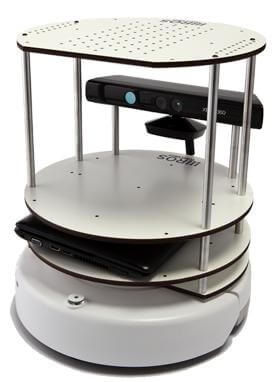
For those that have been drooling over Willow Garage’s PR2, the Silicon Valley robotics company has a way to curb your hunger. Starting early this summer, Willow Garage will be shipping orders of TurtleBot, their first low-cost personal robot. Check it out in the video below. While it doesn’t have the PR2’s humanoid shape, TurtleBot will be able to access the same open source software of its big brother via the Robot Operating System (ROS). In typical Willow Garage fashion, engineers worked smarter, not harder, to design the TurtleBot hardware. It’s constructed from an iRobot create, a Kinect 3D sensor, a laptop, and a gyro – all you need for a wide variety of applications. TurtleBot’s pre-order pricetag is $500 if you have your own iRobot and laptop, or $1200 for the whole enchilada. That’s still a big investment, but much easier than shelling out $400,000 for a PR2. Combining low cost hardware and ROS, TurtleBot could become a great development platform for engineers of all calibers. Thanks to Willow Garage, open source robotics just got a big boost…again.
First and foremost, Willow Garage is a company seemingly obsessed with creating the upcoming era of personal robotics. They’re main focus, the PR2, is a high tech research platform aimed at well-funded universities or industrial labs. You can tell from this video, however, that TurtleBot hits a little closer to their dream. This is a labor of love if I’ve ever seen one. Are we looking at a robot or a pet?
As cool as the concept of TurtleBot may be, it’s not what I pictured. When I heard Willow Garage had created a (relatively) cheap personal robot for entry level developers, I didn’t expect a Kinect hacked onto an iRobot create. Honestly, and I say this with love, I thought Willow Garage was cheating. After all, couldn’t you or I have done this on our own? Well, maybe. The Asus Eee PC 1215N dual-core Atom notebook and the iRobot Create cost about $700 together (making the $500/$1200 pricing options about perfect). The Kinect costs around $150…so what are you getting for the remaining $350? Well, there’s some more valuable hardware: a gyro that improves navigation, a cool frame that makes it easy to expand, etc…but as I look more at TurtleBot I realize that what you’re really buying is some well designed synergy. Willow Garage has put a lot of effort into getting TurtleBot to work as a development platform. Top to bottom, it represents a system that you can easily assemble out of the box and trust it will work well. In fact, the connections and cables Willow Garage put together in the kit keep you from having to perform any soldering – you can put TurtleBot together with nothing more than the little screwdriver that comes in the box. Yet the TurtleBot frame is robust enough to handle any hardwire upgrades that you’d want. Is that good design worth the price?
There’s an understated benefit here: standardization. With its ease of assembly, you’ll not only be up and running faster, you’ll be using the same kit as all the others TurtleBot developers out there. The standardization is greatly amplified because TurtleBot’s SDK is based in ROS, which is open source. While it is an independent organization, ROS is practically one of Willow Garage’s babies. The range of code on ROS is expanding everyday, fueled in no small part by the constant work of Willow Garage’s engineers. Hardware wise, TurtleBot may or may not be that great of a bargain, but it has one helluva software support team to say the least.
I’m really excited to see what TurtleBot users add to the open robotics community. Even at $1200, the platform is well within the range of many other robotics kits out there. Imagine if ROS suddenly had thousands of new developers in the next few years. We’ve already seen how Willow Garage and ROS have promoted open source robotics development with projects like the Kinect hacking competition. What kind of valuable code could we expect when we have people all over the world teaching their TurtleBot new tricks? In that light, TurtleBot’s composite behavior could prove to be an amazing godsend. Code written for TurtleBot is essentially code written for the popular Kinect 3D sensor or for iRobot’s Create. Under the right circumstances we could see an explosion in open source software even as the robotics community is tied together by sharing a popular development platform.
There’s little doubt that Willow Garage is aiming for exactly such an explosion. Their slogan for the new Turtlebot? “Get Ready for Apps on Wheels.” As Google and Apple have shown, once the right development platform emerges, the market for third party applications goes through the roof. I’m not sure that TurtleBot is the personal robot that we’ll all have in our homes (I actually think we’d need something a little crisper looking for that), but it has all the ingredients necessary to become the foundation upon which that mainstream personal robot is built. Those developers who get in now could be signing up for a future where their apps are on retail robots all over the world. Enticed yet? It’s no surprise. Willow Garage keeps making very smart moves in their quest to create the personal robot of the future. It’s too early to know if TurtleBot will be another such success, but I wouldn’t bet against it.
[image and video credits: Willow Garage]
[sources: Willow Garage blog, ROS]



